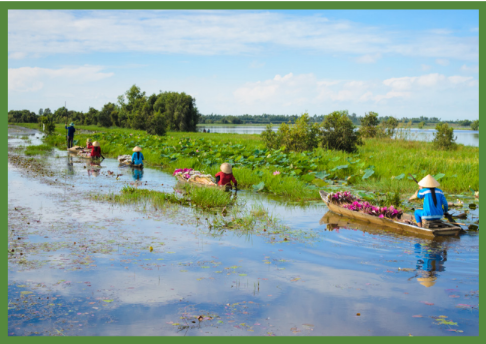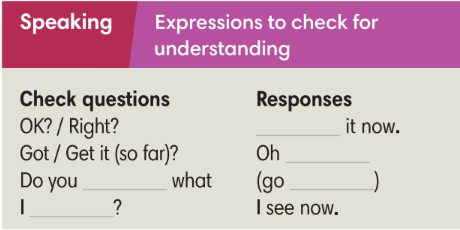Tiếng Anh 8 Unit 5 5.6 Speaking1. Listen and answer the questions below. 2. Complete the phrases from the dialogue. 3. Circle the best option. 4. Reorder the lines of this dialogue. The first line is given. 5. Work in pairs. Student A reads about Lạng Sơn. Student B reads about Trà Vinh on page 102. Then ask and answer about each place. Remember to check understanding.
Lựa chọn câu để xem lời giải nhanh hơn
Bài 1 1. Listen and answer the questions below. (Nghe và trả lời các câu hỏi dưới đây.) 1. What did Thu do in Cù lao Giêng? (Thu đã làm gì ở Cù lao Giêng?) 2. How are the people in Cù lao Giêng? (Người dân ở Cù lao Giêng như thế nào?)
Phương pháp giải: Bài nghe: Daniel: How was your trip to Cù Lao Giêng Island, Thu? Thu: It was great. It is less crowded there, and I like the slower pace of life along the Tiên River. Daniel: Are there a lot of great places for teenagers to hang out there? Thu: Not, really. It's a small town on an island in the Mekong River. Thu: Do you see what I mean? It's not a big city. It's quiet and peaceful. Daniel: Oh yes, go on. It's like that village we visited last summer. Thu: Exactly. But this is located in southern Việt Nam. A lot of the villagers in Cù Lao Giêng are fishermen. Daniel: I see. Did you make any new friends? Thu: Yes, my cousins introduced me to some of their friends. People in Cù Lao Giêng are friendly. Daniel: Your cousins? Thu: Oh I forgot to mention, my cousins live in Cù Lao Giêng, so I went there to stay with them. Daniel: I get it now. Thank you. Lời giải chi tiết: 1. What did Thu do in Cù lao Giêng? (Thu đã làm gì ở Cù lao Giêng?) => She made some new friends. (Cô ấy kết bạn mới.) Thông tin: Daniel: I see. Did you make any new friends? (Tôi hiểu rồi. Bạn có kết bạn mới không?) Thu: Yes, my cousins introduced me to some of their friends. (Có chứ, chị em họ của tôi đã giới thiệu cho tôi vào người bạn của họ.) 2. How are the people in Cù lao Giêng? (Người dân ở Cù lao Giêng như thế nào?) => They are friendly. (Họ thân thiện.) Thông tin: People in Cù Lao Giêng are friendly. (Người dân ở Cù Lao Giêng rất thân thiện.) Lời giải chi tiết: Đang cập nhật! Bài 2 2. Complete the phrases from the dialogue. (Hoàn thành các cụm từ từ cuộc đối thoại.)
Lời giải chi tiết:
Bài 3 3. Circle the best option. (Khoanh tròn phương án đúng nhất.) Mi: You want to come with me to Cù lao Giêng Island. (1Right? Go on.) Jason: (2OK? / Oh, yes.) Mi: Well, then let’s meet at my house at 7.99 tomorrow morning. We need to leave before the traffic gets bad. Jason: Oh, that’s quite early. Can we meet at 8.00 a.m? Mi: The traffic will already be bad then, and it will take us a long time to get there. Jason: It was quite bad this morning. Mi: (3Do you see what I mean? / I get it now.) Jason: (4Do you see what I mean? / I get it now.) See you at 7.00 then. Phương pháp giải: Right? Go on: Đúng chứ?/ Tiếp tục đi. OK? / Oh, yes: Đồng ý không? / Ồ, vâng. Do you see what I mean? / I get it now: Bạn có hiểu ý mình không? / Giờ thì mình hiểu rồi. Lời giải chi tiết:
Mi: You want to come with me to Cù lao Giêng Island. 1Right? Jason: 2Oh, yes. Mi: Well, then let’s meet at my house at 7.00 tomorrow morning. We need to leave before the traffic gets bad. Jason: Oh, that’s quite early. Can we meet at 8.00 a.m? Mi: The traffic will already be bad then, and it will take us a long time to get there. Jason: It was quite bad this morning. Mi: 3Do you see what I mean? Jason: 4I get it now. See you at 7.00 then. Tạm dịch: Mi: Bạn muốn cùng mình đến Cù lao Giêng. Phải không? Jason: Ồ, vâng. Mi: Vậy thì hãy gặp nhau ở nhà mình lúc 7:00 sáng mai. Chúng ta cần rời đi trước khi giao thông trở nên tồi tệ. Jason: Ồ, lúc đó khá sớm. Chúng ta có thể gặp nhau lúc 8 giờ sáng không? Mi: Lúc đó giao thông sẽ rất tệ và chúng ta sẽ mất nhiều thời gian để đến đó. Jason: Sáng nay trời khá tệ. Mi: Bạn hiểu ý mình chứ? Jason: Mình hiểu rồi. Vậy gặp bạn lúc 7.00 nhé. Bài 4 4. Reorder the lines of this dialogue. The first line is given. (Sắp xếp lại các dòng của cuộc đối thoại này. Dòng đầu tiên được cho.) _______ A: What’s your hometown like? _______ B: Oh, no! It’s much smaller than Huế. We have to buy things at a market in a neighbouring village. Do you see what I mean? _______ A: Oh, I see now. _______ A: How many shopping centers does it have? _______ B: It only has 200 people, so it doesn’t have only. _______ A: I get it now. It’s like Huế? _______ B: Well, it’s a small town near the sea, and it’s simple and quiet. Lời giải chi tiết: A: What’s your hometown like? B: Well, it’s a small town near the sea, and it’s simple and quiet. A: How many shopping centers does it have? B: It only has 200 people, so it doesn’t have only. A: I get it now. It’s like Huế? B: Oh, no! It’s much smaller than Huế. We have to buy things at a market in a neighbouring village. Do you see what I mean? A: Oh, I see now. Tạm dịch: A: Quê hương của bạn như thế nào? B: Chà, đó là một thị trấn nhỏ gần biển, đơn giản và yên tĩnh. A: Nó có bao nhiêu trung tâm mua sắm? B: Nó chỉ có 200 người, vì vậy nó không có trung tâm mua sắm nào cả. A: Mình hiểu rồi. Có giống Huế không? B: Ồ, không! Nó nhỏ hơn nhiều so với Huế. Chúng mình phải mua đồ ở chợ ở làng bên. Bạn có hiểu ý mình là gì không? A: Ồ, mình hiểu rồi. Bài 5 5. Work in pairs. Student A reads about Lạng Sơn. Student B reads about Trà Vinh on page 102. Then ask and answer about each place. Remember to check understanding. (Làm việc theo cặp. Học sinh A đọc về Lạng Sơn. Học sinh B đọc về Trà Vinh ở trang 102. Sau đó hỏi và trả lời về từng nơi. Hãy nhớ kiểm tra sự hiểu biết.)
Questions to ask about Trà Vinh (Những câu hỏi về Trà Vinh) 1. What do most people do in Trà Vinh? (Hầu hết mọi người làm gì ở Trà Vinh?) 2. How is the cost of living in Trà Vinh? (Chi phí sinh hoạt tại Trà Vinh như thế nào?) 3. How do people in Trà Vinh travel? (Người dân Trà Vinh đi lại như thế nào?) 4. What is the average temperature in Trà Vinh? (Nhiệt độ trung bình ở Trà Vinh là bao nhiêu?) 5. What is the total population of Trà Vinh? (Trà Vinh có tổng dân số là bao nhiêu?) 6. How many ethnic groups are there in Trà Vinh? (Trà Vinh có bao nhiêu dân tộc?) Phương pháp giải:
Lời giải chi tiết: 1. They develop nature-based tourism. (Họ phát triển du lịch dựa vào thiên nhiên.) 2. The cost of living in Trà Vinh is low. (Chi phí sinh hoạt ở Trà Vinh thấp.) 3. People in Trà Vinh travel by bus, boat, car, motorbike, or bike. (Người dân Trà Vinh di chuyển bằng xe buýt, thuyền, ô tô, xe máy hoặc xe đạp.) 4. The average temperature in Trà Vinh is 26℃ - 27℃. (Nhiệt độ trung bình ở Trà Vinh là 26℃ - 27℃.) 5. It was 160,310 in 2018. (Năm 2018 là 160.310 người.) 6. There are three ethnic groups are there in Trà Vin: Kinh, Khmer, and Hoa. (Có ba dân tộc ở Trà Vin: Kinh, Khmer và Hoa.)
|
||||||||||||||||||||||||||||||||||||















